During my 15 minutes of focus I noticed a large number of tiny bugs and gnats hovering in the air around me. I forgot my bug repellent spray, so they kept biting me, which was distracting and frustrating. Leaves continuously fell from the surrounding trees above and around me, providing a serene and relaxing environment. A bee paid me a visit, landing on my writing hand as I took notes in my journal and grabbing my attention. He crawled in and out of my hand, between my fingers, and back and forth across my hand, searching for something I didn’t have. Once he realized I had nothing to offer he flew away, to my relief. I realized after the fact that I had been only focusing on the bee and nothing else and had likely missed a few things during the small chunk of time that it was on my hand.
I saw a groundhog on the other side of the stream while walking to my sit spot, but he would have been hidden from view if I had already sat down. The sunlight peered through the falling leaves from the west, casting a warm glow through the tree branches. The sound of rustling leaves and cracking branches filled the air, as did the faint chirping of crickets and birds. The air was warm, and the weather was beautiful, and my only annoyance was the constant biting of bugs. Water striders swam lazily across the stream’s surface, and I thought I saw a small fish swim past, but I couldn’t be sure. The water was crystal clear, and I could see piles of fallen leaves resting at the stream’s bottom. I could hear the chirps and calls of birds but didn’t actually see any. I wish I could have seen at least a few of them, and maybe even identified them for my journal and my own curiosity.
I closed my eyes for 5 minutes to auditorily tune into my surroundings. I heard a bird calling obnoxiously to my south east and could hear that it had flown down from the top of the trees to the ground based on the movement of its cawing. I screamed from the location for another couple moments before flying away into the distance. I heard crickets chirping at a distance and occasional tweets and chirps from other birds. I could hear the leaves rustle and fall from the nearby trees. At one point a bug landed on my face, which caught me off guard. I didn’t imagine my sit spot any differently with my eyes closed but found it much more difficult to focus. It took a lot of concentration to continue to put my effort into listening, and not to just zone out or fall asleep.
Three species that I tried to identify were a spider, a shrub, and a beetle. Using iNaturalist, I identified the spider as a thin-legged wolf spider from the genus Pardosa, and when I looked up this species online, it looks to match. According to information I found online, this spider is in the Family Lycosidae, and can grow to be anywhere between 3 mm and 10 mm in length. Through online research I also learned that these spiders have reflective eyes, like those of a cat or dog, and if you shine a light at them in the dark, you can see their eyes glow. I also learned that this spider is venomous, although its bite is no more harmful to humans than a bee sting. Still, with this new knowledge I don’t think I will get as close to one the next time one wanders into my sit spot. It was interesting to learn more about their feeding habits (they don’t use webs, but instead wander in search of insect prey) and connect that to the behavior I noticed in this spider in my sit spot, and be able to apply that in the future when identifying similar spiders.
Using iNaturalist, I identified the shrub in my sit spot as a Virginia sweetspire. Just by the pictures given I could tell that this was definitely the right plant. The Virginia sweetspire belongs to the family Grossulariaceae, and is commonly found growing in moist conditions or along riverbanks. Additionally, it’s leaves turn red-purple in the fall, just like I had observed in my sit spot. This shrub prefers moist, rich, and slightly acidic, humusy soils, but tolerates a wide range of soil and pH conditions. It also prefers partial sun to partial shade. These characteristics all match those in my sit spot, so I am 100% certain that the shrub in my sit spot is a Virginia sweetspire. I chose this shrub as one of the three things in my sit spot to keep track of, so I am glad that I finally identified its species. I think that knowing this will help me to better understand this shrub in future visits to my sit spot, as well as to better abserve normal and abnormal changes or patterns that it experiences.
Using iNaturalist, I also identified the beetle, which I found to be a clicking beetle of the family Elateridae and genus Melanotus. After conducting some research online, I found that this type of beetle gets its name from its ability to use a stiff spine on its underside to create a loud and forceful click. This is used to scare off predators and flip the beetle back onto its feet if it gets stuck on its back. Judging by the pictures online, I’d say that the beetle matches that I observed matches with this species. Knowing this information will help me to better identify similar beetles in my sit spot in the future, as well as understand their defense characteristics. After identifying and researching this beetle I can better understand its reactions should I see it again, as well as know what the clicking noise is that it produces should I hear it in the future, and use this to identify future beetles.
I left my sit spot at 5:35 p.m. Overall, I think that this was a successful sit spot experience. I would be curious to work on auditory tuning in the future, perhaps on a day when I am less tired, and see if I can remain alert and focused for longer than 10 minutes. Additionally, I’d like to try to continue to identify species in the sit spot, whether they are large trees or tiny insects. I feel that I learned a lot from this visit, and look forward to my next journal entry.
(As a side not, when I arrived at my sit spot I immediately noticed that the bench (my sitting spot) had been moved out into the garden field and replaced with a plastic lounge chair. I am curious to see if it is put back to its original position by my next visit).

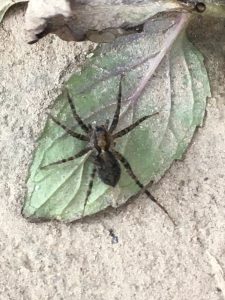
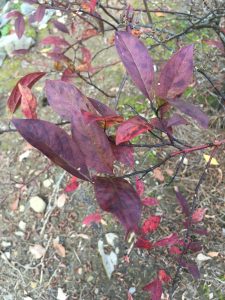
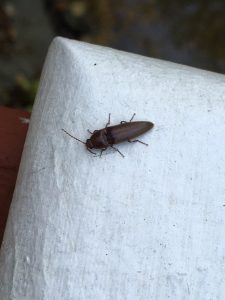


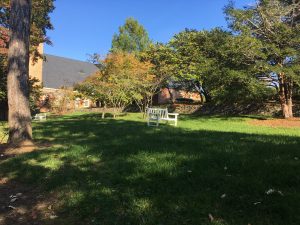
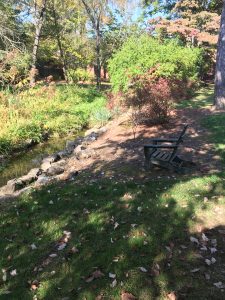
Click Beetle. (n.d.). Retrieved October 21, 2020, from https://www.insectidentification.org/insect-description.asp? identification=Click-Beetle
Itea virginica. (n.d.). Retrieved October 21, 2020, from https://plants.ces.ncsu.edu/plants/itea-virginica/
Thin-legged Wolf Spider. (n.d.). Retrieved October 21, 2020, from https://www.insectidentification.org/insect-description.asp?identification=Thin-Legged-Wolf-Spider


That seems like a huge spider. Did you get a measurement?
You screamed??? My guess is you meant the crow…alas for a t….
Nice blog – and you got some good use of inaturalist!